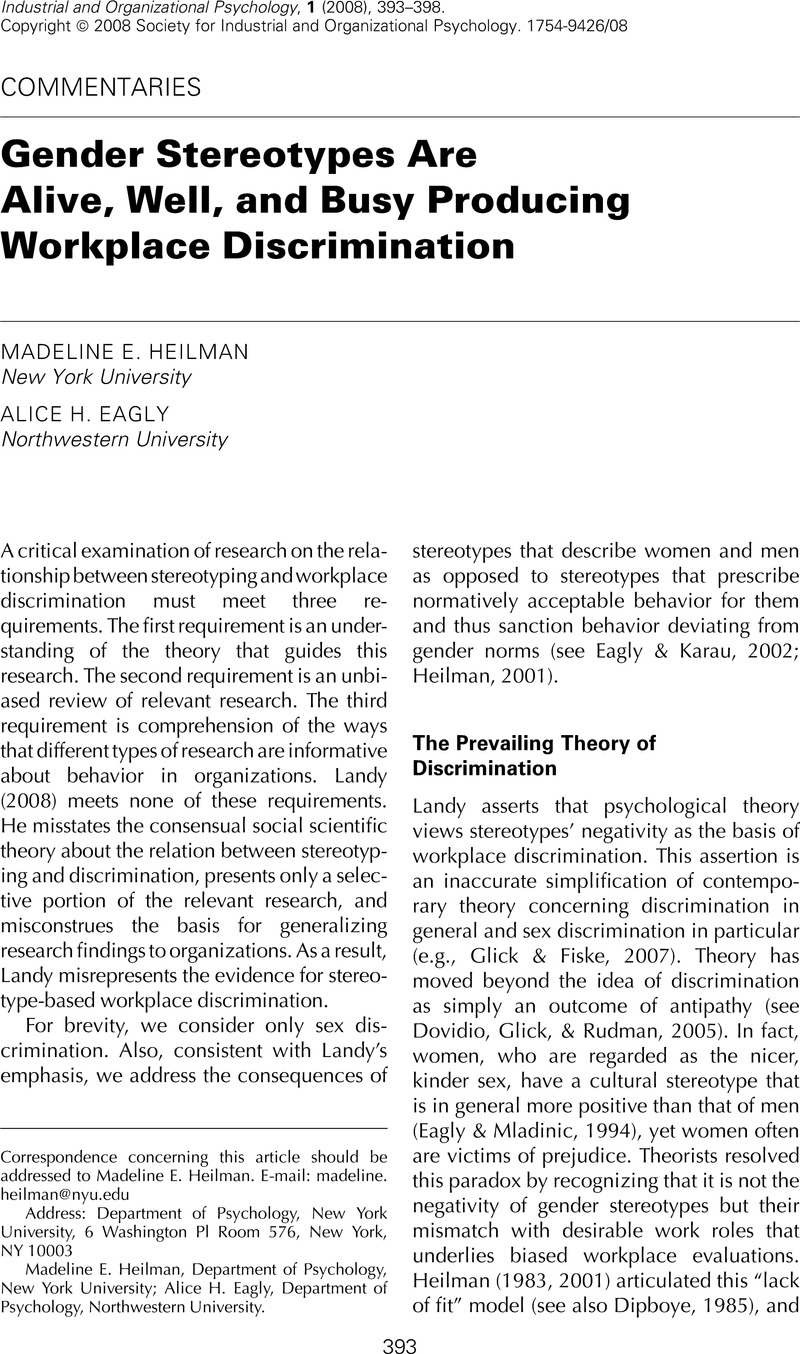Crossref Citations
This article has been cited by the following publications. This list is generated based on data provided by Crossref.
Landy, Frank J.
2008.
Stereotyping, Implicit Association Theory, and Personnel Decisions: I Guess We Will Just Have to Agree to Disagree.
Industrial and Organizational Psychology,
Vol. 1,
Issue. 4,
p.
444.
Kark, Ronit
and
Eagly, Alice H.
2010.
Handbook of Gender Research in Psychology.
p.
443.
HIRSCHFELD, ROBERT R.
and
THOMAS, CHRISTOPHER H.
2011.
AGE‐ AND GENDER‐BASED ROLE INCONGRUENCE: IMPLICATIONS FOR KNOWLEDGE MASTERY AND OBSERVED LEADERSHIP POTENTIAL AMONG PERSONNEL IN A LEADERSHIP DEVELOPMENT PROGRAM.
Personnel Psychology,
Vol. 64,
Issue. 3,
p.
661.
Triana, María del Carmen
2011.
A Woman’s Place and a Man’s Duty: How Gender Role Incongruence in One’s Family Life Can Result in Home-Related Spillover Discrimination at Work.
Journal of Business and Psychology,
Vol. 26,
Issue. 1,
p.
71.
Hoyt, Crystal L.
Simon, Stefanie
and
Innella, Audrey N.
2011.
Taking a Turn Toward the Masculine: The Impact of Mortality Salience on Implicit Leadership Theories.
Basic and Applied Social Psychology,
Vol. 33,
Issue. 4,
p.
374.
Kyriakidou, Olivia
Loughlin, Catherine
Arnold, Kara
and
Bell Crawford, Janet
2011.
Lost opportunity.
Equality, Diversity and Inclusion: An International Journal,
Vol. 31,
Issue. 1,
p.
43.
Virick, Meghna
and
Greer, Charles R.
2012.
Gender diversity in leadership succession: Preparing for the future.
Human Resource Management,
Vol. 51,
Issue. 4,
p.
575.
Haynes, Michelle C.
and
Lawrence, Jason S.
2012.
Who's to Blame? Attributions of Blame in Unsuccessful Mixed-Sex Work Teams.
Basic and Applied Social Psychology,
Vol. 34,
Issue. 6,
p.
558.
Gillespie, Jennifer Z.
and
Ryan, Ann Marie
2012.
Gender‐Based Preferential Selection: Influences of Perceptions of Procedurally Unfair Advantage on Performance and Self‐Evaluations.
Journal of Applied Social Psychology,
Vol. 42,
Issue. S1,
Truxillo, Donald M.
McCune, Elizabeth A.
Bertolino, Marilena
and
Fraccaroli, Franco
2012.
Perceptions of Older Versus Younger Workers in Terms of Big Five Facets, Proactive Personality, Cognitive Ability, and Job Performance.
Journal of Applied Social Psychology,
Vol. 42,
Issue. 11,
p.
2607.
Martell, Richard F.
Emrich, Cynthia G.
and
Robison-Cox, James
2012.
From bias to exclusion: A multilevel emergent theory of gender segregation in organizations.
Research in Organizational Behavior,
Vol. 32,
Issue. ,
p.
137.
Li Kusterer, Hanna
Lindholm, Torun
and
Montgomery, Henry
2013.
Gender typing in stereotypes and evaluations of actual managers.
Journal of Managerial Psychology,
Vol. 28,
Issue. 5,
p.
561.
Haynes, Michelle C.
and
Heilman, Madeline E.
2013.
It Had to Be You (Not Me)!.
Personality and Social Psychology Bulletin,
Vol. 39,
Issue. 7,
p.
956.
Galinsky, Adam D.
Hall, Erika V.
and
Cuddy, Amy J. C.
2013.
Gendered Races.
Psychological Science,
Vol. 24,
Issue. 4,
p.
498.
Arnold, Kara A.
and
Loughlin, Catherine
2013.
Integrating transformational and participative versus directive leadership theories.
Leadership & Organization Development Journal,
Vol. 34,
Issue. 1,
p.
67.
Wilks, Daniela Carvalho
and
Neto, Félix
2013.
Workplace Well-being, Gender and Age: Examining the ‘Double Jeopardy’ Effect.
Social Indicators Research,
Vol. 114,
Issue. 3,
p.
875.
Martinez, Larry R.
Ruggs, Enrica N.
Sabat, Isaac E.
Hebl, Michelle R.
and
Binggeli, Steve
2013.
The Role of Organizational Leaders in Sexual Orientation Equality at Organizational and Federal Levels.
Journal of Business and Psychology,
Vol. 28,
Issue. 4,
p.
455.
Hess, Kathleen P.
2013.
Investigation of nonverbal discrimination against women in simulated initial job interviews.
Journal of Applied Social Psychology,
Vol. 43,
Issue. 3,
p.
544.
Jagsi, Reshma
Griffith, Kent A.
Stewart, Abigail
Sambuco, Dana
DeCastro, Rochelle
and
Ubel, Peter A.
2013.
Gender Differences in Salary in a Recent Cohort of Early-Career Physician–Researchers.
Academic Medicine,
Vol. 88,
Issue. 11,
p.
1689.
N. Ruggs, Enrica
R. Hebl, Michelle
Singletary Walker, Sarah
and
Fa-Kaji, Naomi
2014.
Selection biases that emerge when age meets gender.
Journal of Managerial Psychology,
Vol. 29,
Issue. 8,
p.
1028.





